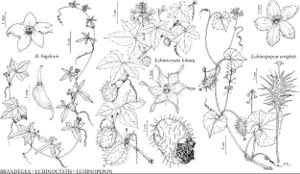Echinopepon wrightii
Bull. Torrey Bot. Club 14: 158. 1887.
Stems 0.5–4 m, hirsute, hairs stipitate-glandular. Leaf-blades reniform to orbiculate, angular or undulate to shallowly lobed, 5–8 (–15) cm wide, base broadly cordate, margins entire or denticulate, surfaces hispid to hispidulous. Inflorescences: staminate flowers in simple or compound racemes 6–12 cm. Flowers: sepals narrowly triangular; petals triangular-ovate, 3–4 mm, apex acute to slightly obtuse, surfaces stipitate-glandular abaxially, punctate-glandular adaxially, corolla rotate, 6–8 mm diam.; anther thecae arcuate. Capsules tapering to base, 2.5–3 × 1.4–1.8 cm, surface and prickles hirsute, hairs stipitate-glandular, beak 10 mm, prickles 10–20 mm. Seeds without depression on surfaces. 2n = 24.
Phenology: Flowering Jun–Oct.
Habitat: Canyon bottoms, washes, cliff bases, desert grasslands, oak woodlands, desert scrub, riparian scrub and woodlands, roadsides, orchards
Elevation: 500–1500 m
Distribution

Ariz., N.Mex., Tex., Mexico (Chihuahua), Mexico (Sonora), Mexico (Zacatecas)
Discussion
Records for Echinopepon wrightii in the flora area are from four counties in New Mexico and from seven counties in Arizona. The species is included here for Texas on the basis of the statement by D. S. Correll and M. C. Johnston (1970) that it occurs in extreme west Trans-Pecos Texas; a voucher has not been seen.
The distribution of Echinopepon wrightii was described by A. K. Monro and P. J. Stafford (1998) as only Central Mexico; this obviously was in error. The inclusion of Zacatecas as part of the range of E. wrightii follows their citation of a collection from that state, the only one cited by them apart from the type.
Selected References
None.
